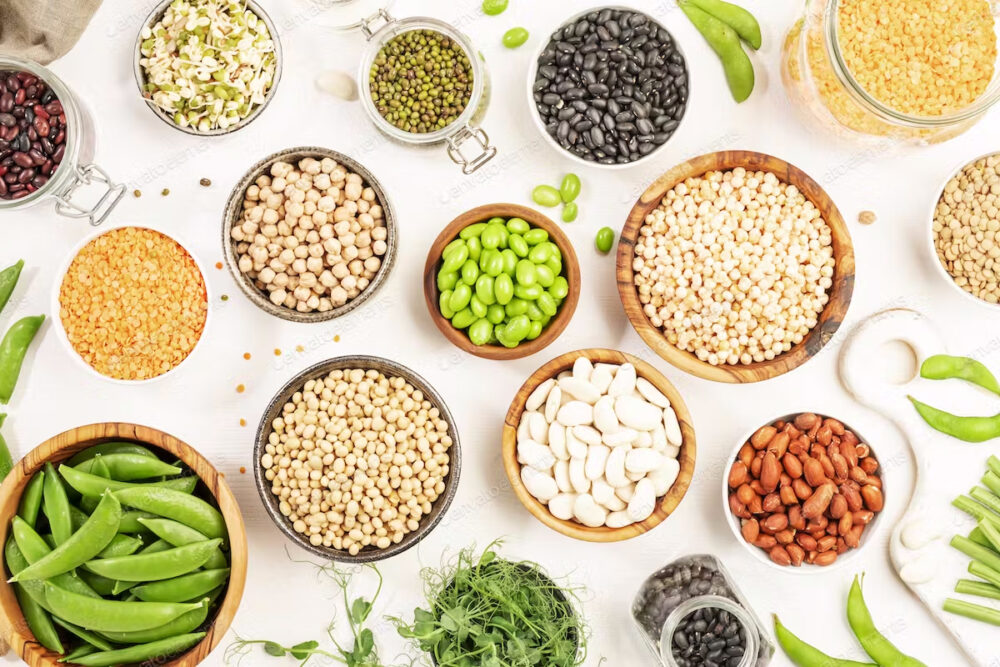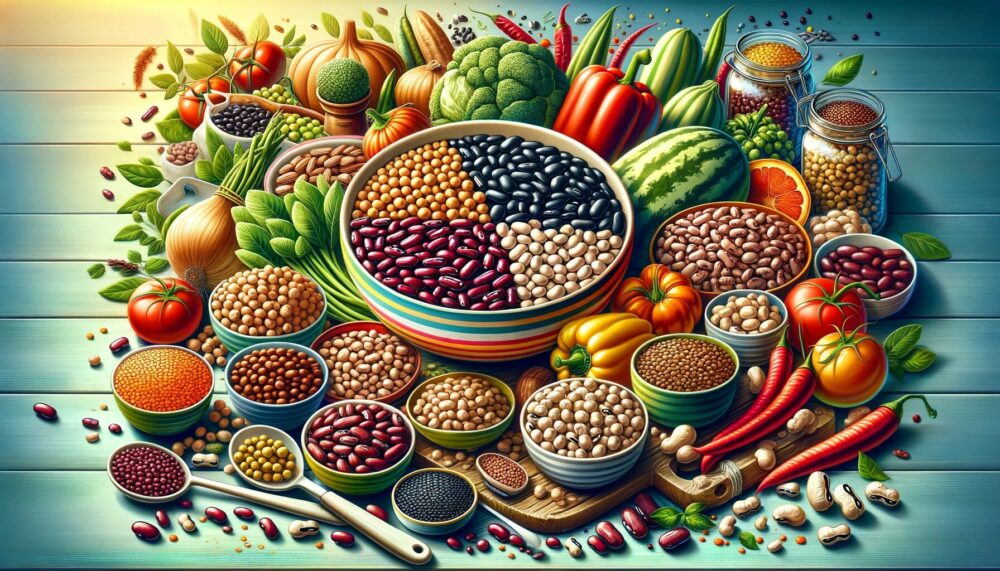Introduction
Beans and legumes stand as pillars of nutritional excellence, seamlessly integrating into various diets and cultures worldwide. Their versatility and health benefits make them an essential part of a balanced diet, offering a rich blend of proteins, fibers, vitamins, and minerals.
Types of Beans and Legumes
Chickpeas, lentils, black beans, kidney beans, soybeans, pinto beans, navy beans, green peas, and peanuts each bring unique flavors and characteristics to the table. These varieties ensure diverse options for different culinary preferences and nutritional needs.
Nutritional Profile
Beans contain protein, fiber, folate, iron, potassium, and magnesium while containing little or no total fat, trans-fat, sodium, and cholesterol. Eating beans or legumes as part of your diet provides the following dietary values.
Proteins
Beans and legumes are powerhouses of plant-based protein, crucial for muscle building and repair. They serve as an excellent protein source, especially in vegetarian and vegan diets.
Dietary Fiber
High in dietary fiber, beans and legumes aid in digestion and promote gut health. This fiber content is essential for maintaining a healthy digestive system.
Vitamins and Minerals
Packed with key vitamins like folate and thiamine and minerals such as iron, magnesium, and potassium, beans and legumes contribute significantly to overall nutritional intake.
Health Benefits of Beans

Beans may help reduce cholesterol, decrease blood sugar levels, and increase healthy gut bacteria. According to the U.S. Department of Agriculture, Beans are a versatile food that can be used in many ways. They are packed with important nutrients that help to maintain good health. Beans make a fantastic addition to any pantry, offering a burst of color, flavor, and texture to a wide array of dishes. Available in a variety of shapes and sizes, beans are a nutritious and versatile choice for enhancing your diet.
Heart Health
Regular consumption of beans and legumes can significantly contribute to heart health for several reasons:
- High Fiber Content: Beans and legumes are rich in soluble fiber, which is known for its ability to lower levels of LDL cholesterol (often referred to as “bad” cholesterol). Lower LDL cholesterol levels are associated with a reduced risk of heart disease.
- Plant Proteins: As a source of plant-based protein, beans and legumes can be a healthier alternative to some animal proteins that are high in saturated fat. Diets high in saturated fat can increase heart disease risk, so replacing these with plant proteins can be beneficial.
- Antioxidants and Phytonutrients: Beans and legumes contain a variety of antioxidants and phytonutrients. These compounds help reduce oxidative stress and inflammation in the body, both of which are risk factors for heart disease.
- Potassium and Magnesium: These minerals, found abundantly in beans and legumes, are essential for heart health. Potassium helps regulate blood pressure, while magnesium is known for its role in maintaining a healthy heartbeat and preventing arrhythmias.
- Low Glycemic Index: Beans and legumes have a low glycemic index, meaning they cause a slower, more gradual rise in blood sugar levels. This is beneficial for heart health as high blood sugar levels and insulin resistance are risk factors for heart disease.
- Nitric Oxide Production: Some beans, like soybeans, are high in arginine, an amino acid that helps produce nitric oxide. Nitric oxide is important for blood vessel relaxation and blood pressure regulation.
Blood Sugar Control
Their low glycemic index makes them beneficial for blood sugar control, offering steady energy and aiding in diabetes management.
This is primarily due to their low glycemic index (GI) and high fiber content, which together play a crucial role in managing blood sugar levels:
- Low Glycemic Index: The glycemic index is a measure of how quickly foods raise blood sugar levels after eating. Foods with a low GI, like beans and legumes, are digested and absorbed more slowly. This slower digestion and absorption process results in a gradual rise in blood sugar levels rather than a rapid spike. This is particularly beneficial for individuals with diabetes, as it helps maintain stable blood sugar levels.
- High Fiber Content: Beans and legumes are rich in dietary fiber, especially soluble fiber. Soluble fiber slows down the digestion process and the absorption of carbohydrates. This means that the release of glucose (sugar) into the bloodstream is more controlled, preventing sudden spikes in blood sugar levels. Consistent blood sugar levels help in managing both Type 1 and Type 2 diabetes.
- Protein and Healthy Fats: Besides fiber, beans and legumes also contain protein and, in some cases, healthy fats. These nutrients have minimal impact on blood sugar levels and can help in creating a balanced meal with a lower overall glycemic load. This is important for preventing rapid increases in blood sugar.
- Improved Insulin Sensitivity: Regular consumption of beans and legumes can improve insulin sensitivity over time. Better insulin sensitivity means the body is more effective at using the hormone insulin to lower blood sugar levels after meals.
- Nutrient-Rich Profile: Beans and legumes are also rich in vitamins and minerals, such as magnesium, which has been linked to improved insulin sensitivity and overall blood sugar regulation.
The low glycemic index, high fiber content, and nutrient-rich profile of beans and legumes make them excellent foods for controlling blood sugar levels, providing steady energy, and aiding in the management of diabetes.
Weight Management
Beans and legumes can play a role in weight loss diets because they promote satiety.
They can be particularly beneficial in weight loss diets due to several key factors:
- High Fiber Content: Beans and legumes are very high in dietary fiber, especially soluble fiber. Fiber takes longer to digest, which helps you feel full for a longer period. This prolonged feeling of fullness can reduce overall calorie intake by decreasing the frequency of eating and the amount consumed at each meal.
- Protein-Rich: They are also a good source of plant-based protein. Protein is known for its satiating effect, meaning it can help you feel full and satisfied after eating. This is crucial in weight management because it can help curb overeating and snacking on less healthy options.
- Low Energy Density: Beans and legumes have a low energy density, which means they provide fewer calories for a larger volume of food. This allows individuals to eat satisfying portions without consuming too many calories, which is beneficial for weight loss and long-term weight management.
- Balanced Blood Sugar Levels: Due to their low glycemic index, beans and legumes help in maintaining stable blood sugar levels. Stable blood sugar prevents the peaks and troughs that can lead to cravings and overeating, making it easier to stick to a healthy eating plan.
- Nutrient-rich: They are packed with essential nutrients like vitamins and minerals, which are important for overall health. When your body receives adequate nutrition, it can reduce cravings for unhealthy foods that are often high in calories but low in nutritional value.
- Versatility in Meals: Beans and legumes can be used in a variety of dishes, which helps keep meals interesting and satisfying. This versatility can make it easier to stick to a healthy, calorie-controlled eating plan.
Digestive Health
The fiber in beans aids in promoting gut health, supporting a healthy digestive system.
The role of beans in promoting digestive health primarily revolves around their high fiber content:
- High Fiber Content: Beans are an excellent source of dietary fiber, which is crucial for good digestive health. There are two types of fiber in beans – soluble and insoluble, both of which play important roles in the digestive system.
- Soluble Fiber: This type of fiber dissolves in water and forms a gel-like substance in the gut. It can help regulate blood sugar levels and lower cholesterol. Soluble fiber also serves as a prebiotic, providing food for beneficial gut bacteria, which are essential for maintaining a healthy gut microbiome. A healthy gut microbiome is linked to improved digestion and overall health.
- Insoluble Fiber: Insoluble fiber does not dissolve in water. It adds bulk to the stool and helps food pass more quickly through the stomach and intestines, reducing the likelihood of constipation. Regular bowel movements are crucial for preventing digestive disorders like constipation and diverticulosis.
- Promoting Regularity: The combination of soluble and insoluble fiber in beans helps to regulate bowel movements, which is essential for preventing constipation and maintaining a healthy digestive tract. This is where the old song comes from… the more you eat the more you toot!
- Preventing Digestive Disorders: Regular consumption of fiber-rich foods like beans can lower the risk of certain digestive conditions, such as irritable bowel syndrome (IBS), diverticulitis, and hemorrhoids.
- Gut Health and Immune Function: A healthy gut also plays a significant role in the immune system. The fiber in beans supports the growth of beneficial gut bacteria, which are involved in the production of essential nutrients, protection against pathogens, and modulation of immune responses.
- Nutrient Absorption: Fiber in beans can also aid in the absorption of nutrients by slowing down digestion, allowing for more thorough nutrient uptake from the food we eat.
Cholesterol Reduction
The ability of beans and legumes to help lower LDL cholesterol levels, which is often referred to as “bad” cholesterol, is attributed to several factors:
- High Soluble Fiber Content: Beans and legumes are rich in soluble fiber. This type of fiber binds to cholesterol in the digestive system and helps remove it from the body. When soluble fiber binds with cholesterol, it prevents the cholesterol from being absorbed into the bloodstream. Instead, cholesterol is excreted from the body along with the fiber. This process effectively lowers the levels of LDL cholesterol.
- Plant Sterols and Stanols: Beans and legumes contain plant sterols and stanols, which are naturally occurring substances in plants that have a chemical structure similar to cholesterol. They compete with cholesterol for absorption in the digestive system. By blocking the absorption of cholesterol, they help lower the levels of LDL cholesterol in the blood.
- Healthy Fats: While beans and legumes are low in fat, they do contain small amounts of healthy polyunsaturated and monounsaturated fats. These types of fats are beneficial for heart health and can help reduce LDL cholesterol levels when they replace saturated fats and trans fats in the diet.
- Protein Source: Beans and legumes are a great source of plant-based protein. Diets high in plant proteins and lower in animal proteins have been associated with lower levels of LDL cholesterol. This is partly because plant-based diets typically include less saturated fat, which can raise cholesterol levels.
- Weight Management: Regular consumption of beans and legumes can aid in weight management due to their high fiber and protein content, which promote satiety. Maintaining a healthy weight is crucial for managing cholesterol levels.
- Antioxidant Properties: Beans and legumes are also rich in antioxidants, which can help reduce oxidative stress and inflammation in the body. Chronic inflammation and oxidative stress are linked to higher LDL cholesterol levels and an increased risk of heart disease.
Dietary Considerations

Absolutely! Beans and legumes are incredibly versatile and can be incorporated into a variety of dishes that cater to different dietary needs, such as vegetarian, vegan, gluten-free, and even low-carb diets. Here are a couple of example dishes for each dietary consideration:
Vegetarian and Vegan Diets
- Chickpea Curry: A hearty and flavorful dish made with chickpeas, tomatoes, onions, garlic, and a blend of spices like cumin, coriander, and turmeric. Serve it over rice or with naan bread for a satisfying meal.
- Black Bean Veggie Burgers: These burgers use mashed black beans mixed with vegetables like bell peppers and onions, along with breadcrumbs and spices. They’re great grilled or pan-fried and served on a whole-grain bun with your favorite toppings.
Gluten-Free Diet
- Lentil Soup: A nourishing soup made with lentils, carrots, celery, onions, and herbs. It’s naturally gluten-free and perfect for a cozy meal.
- Quinoa and Bean Salad: Combine cooked quinoa with black beans, corn, avocado, and a lime-cilantro dressing. This salad is refreshing, filling, and completely gluten-free.
Low-Carb Diet
- Bean and Avocado Lettuce Wraps: Use large lettuce leaves as wraps filled with a mixture of beans (like navy or pinto beans), diced avocado, tomatoes, and a squeeze of lime. It’s a light yet satisfying low-carb option.
- Mediterranean Chickpea Salad: Mix chickpeas with chopped cucumbers, tomatoes, olives, feta cheese, and a lemon-olive oil dressing. While chickpeas do contain carbs, they are also high in fiber, making them a good option for a lower-carb diet when used in moderation.
Culinary Uses
Beans and legumes are incredibly versatile in the kitchen and can be used in a wide range of culinary applications. Here are some examples highlighting different preparation methods and how they can be incorporated into various dishes:
Boiling
- Classic Bean Chili: A comforting bowl of chili made with kidney beans, tomatoes, bell peppers, onions, and a mix of spices. Boiled beans are perfect for this dish, absorbing the flavors of the spices and other ingredients.
- Minestrone Soup: A hearty Italian soup featuring a mix of vegetables, pasta, and cannellini beans. The beans are boiled until tender and add a wonderful texture to the soup.
Sprouting
- Sprouted Lentil Salad: Sprouted lentils can be tossed with chopped vegetables like cucumbers, tomatoes, and onions, dressed with lemon juice and olive oil for a crunchy and nutritious salad.
- Sprouted Bean Stir-Fry: Use sprouted mung beans or chickpeas in a stir-fry with a variety of vegetables and a savory sauce. Sprouting beans enhances their nutritional value and adds a unique texture to the dish.
Baking
- Baked Black Bean Enchiladas: Rolled tortillas filled with a spicy black bean mixture, topped with enchilada sauce and cheese, and baked until bubbly.
- White Bean and Herb Cassoulet: A baked dish of white beans, carrots, celery, and herbs, topped with breadcrumbs and baked until golden. This is a vegetarian take on the classic French cassoulet.
Blending
- Hummus: A smooth and creamy dip made by blending cooked chickpeas with tahini, garlic, lemon juice, and olive oil. It’s perfect as a spread or a dip for vegetables and pita bread.
- Black Bean Brownies: For a healthier twist on traditional brownies, blend cooked black beans into the batter. This adds fiber and protein, making the brownies more nutritious.
As Standalone Dishes
- Rajma (Red Kidney Bean Curry): A popular North Indian dish where red kidney beans are cooked in a rich tomato-based sauce and served with rice.
- Falafel: Deep-fried balls or patties made from ground chickpeas or fava beans, mixed with herbs and spices. They are commonly served in pita bread with salad and tahini sauce.
Canned Beans VS. Dry Beans
Canned Beans
Canned beans are pre-cooked and ready to use, making them a convenient and time-saving option. They are ideal for quick meals where time is of the essence. However, it’s important to rinse canned beans before use to remove excess sodium and any preservatives.
Rinsing can also help reduce the potential for metal leaching from the can, although this is generally a minor concern as most cans are lined with a protective layer. Canned beans are still a nutritious option, offering similar health benefits to their dried counterparts.
They are particularly useful in dishes where the beans do not need to be the focal texture, such as in soups or purees.
Dry Beans
Dried beans require more preparation time, as they need to be soaked and then boiled. The soaking and boiling process of beans can be a bit more labor-intensive, but it allows for better control over the texture and firmness of the beans.
Dried beans are often more economical than canned beans and have a longer shelf life. They are free from added sodium and preservatives, making them a slightly healthier choice for those closely monitoring their dietary intake.
When cooked, dried beans like black beans or other legumes tend to have a fresher taste and a firmer texture, making them ideal for salads, stews, and dishes where the bean’s texture is important.
In terms of potential health benefits, both canned and dried beans offer a wealth of nutrients including fiber, protein, and essential vitamins and minerals. The choice between canned and dried beans often comes down to personal preference, convenience, and specific dietary needs.
Regardless of the form, incorporating beans into your diet can contribute positively to your overall health.
Sustainability and Environmental Impact
Beans and legumes boast a low carbon footprint, significantly reducing greenhouse gas emissions compared to animal-based proteins. Their growth requires minimal water, making them a water-efficient choice in agriculture. Additionally, their role in crop rotation enhances soil health and promotes biodiversity. The long shelf life of both dried and canned beans aids in reducing food waste, further underscoring their environmental benefits.
Scientific Research and Studies
Numerous studies have underscored the health benefits of beans and legumes, emphasizing their role in preventing and managing various health conditions:
- Heart Health: Research published in the National Library of Medicine found that consuming beans and legumes regularly is associated with reduced risk of heart disease, largely due to their ability to lower LDL cholesterol levels.
- Diabetes Management: A study in the American Journal of Clinical Nutrition showed that a diet high in beans and legumes can improve glycemic control and reduce the risk of developing type 2 diabetes.
- Weight Management: The National Health and Nutrition Examination Survey observed that individuals who consume beans regularly have a lower body weight and smaller waist circumference compared to those who don’t.
- Digestive Health: According to research in the Nutrition Journal, the high fiber content in beans and legumes promotes gut health and regular bowel movements, helping to prevent digestive disorders.
- Cancer Prevention: Findings from the American Institute for Cancer Research suggest that the consumption of beans and legumes may offer protective effects against certain types of cancer due to their high fiber and antioxidant content.
Allergies and Intolerances (Potential Health Risks)
Beans and legumes are generally safe and healthy foods for most people, but they can cause allergies or intolerances in some individuals. Here are a few examples:
- Soy Allergy: One of the most common legume allergies is soybeans. People with a soy allergy may experience symptoms ranging from mild (such as hives or itching) to severe (like anaphylaxis) upon consuming soybeans or soy-based products.
- Peanut Allergy: Peanuts, although often grouped with nuts, are legumes. Peanut allergies can be severe and even life-threatening, and they require strict avoidance of peanuts and peanut-containing products.
- Lectin Sensitivity: Lectins are a type of protein found in many beans and legumes, and they can cause digestive distress in some people. This is particularly the case with undercooked or improperly prepared beans.
- FODMAP Intolerance: For individuals with irritable bowel syndrome (IBS) or similar gastrointestinal issues, beans and legumes can trigger symptoms due to their high FODMAP content. FODMAPs are a collection of short-chain carbohydrates that some people find difficult to digest.
- G6PD Deficiency: People with G6PD deficiency, a genetic enzyme deficiency, may need to avoid certain legumes like fava beans, as they can trigger hemolytic anemia.
Individuals with known allergies or intolerances need to read food labels carefully and, in the case of severe allergies, carry an epinephrine auto-injector as prescribed. Consulting with a healthcare provider for personalized advice and dietary adjustments is also recommended.
Preparation and Storage Tips
Proper soaking and cooking can enhance the nutritional benefits of beans and legumes. They can be stored effectively for long-term use, maintaining their nutritional value.
Preparation
- Soaking: Soak dried beans in water for several hours or overnight before cooking. This reduces cooking time and can also help decrease the presence of phytates and lectins, which can interfere with nutrient absorption.
- Rinsing: Rinse canned beans thoroughly under cold water to remove excess sodium and any preservatives. This is especially important for those monitoring their salt intake.
- Cooking: Ensure beans are cooked thoroughly to eliminate any harmful toxins (like lectin in red kidney beans) and to improve digestibility. Boiling beans until they are tender is a common and effective method.
Storage
- Dried Beans: Store dried beans in a cool, dry place in airtight containers. They can last for up to two years, but it’s best to use them within a year for optimal quality.
- Cooked Beans: Cooked beans can be stored in the refrigerator for about 3-5 days. Ensure they are cooled and then stored in airtight containers to maintain freshness.
- Freezing: Cooked beans can be frozen for long-term storage. Freeze them in portion-sized containers or freezer bags for easy use. They can last for several months in the freezer.
- Avoiding Humidity and Light: For dried beans, avoid exposure to humidity and light, as these can diminish their quality and shelf life.
Beans Can Help Save You Money
Beans and other legumes are cost-effective, accessible, and shelf-stable, making them an economical choice for a healthy diet.
When considering the economic aspects of beans and legumes, one of the most compelling factors is their cost-effectiveness, particularly in the case of dried beans. On average, the price of dried beans per pound is remarkably affordable, often significantly lower than other protein sources, especially meat. This price point makes beans an accessible option for a wide range of budgets.
Dried beans, sold by the pound, offer exceptional value as they expand in volume when cooked, yielding a substantial amount of servings from a single purchase. This makes them not only a nutritious and versatile choice for meals but also an economical one. Their long shelf life further enhances their economic appeal, as they can be stored for extended periods without loss of quality, reducing the need for frequent purchases.
Conclusion
Incorporating a variety of beans and legumes into your diet can offer numerous health benefits. Their versatility, nutritional value, and delicious taste make them an excellent addition to any meal.








